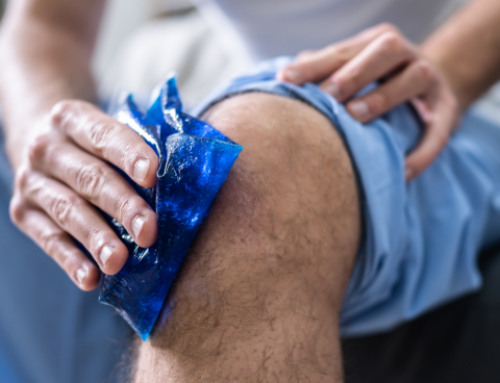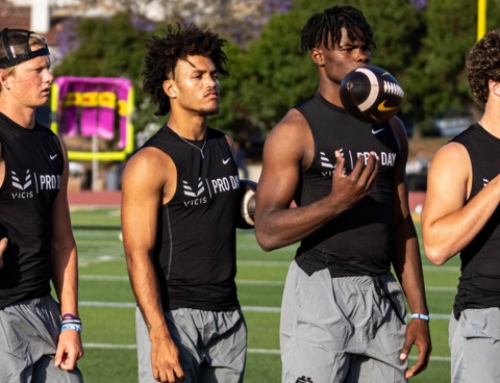STUDY: Football Practice Without Helmets Reduces Concussion Risk, Improves Tackling Ability
![]()
Playing football without a helmet sounds like a recipe for a disaster, right? The helmet offers a critical layer of protection for the fragile head, neck and brain.
Well, as strange as it sounds, occasionally taking off your helmet might be a key to preventing head injuries in football. According to new research published in The Journal of Athletic Training, a helmetless practice program can lead to a significant reduction in football head injuries.
Concussions are the most common serious head injuries sustained by athletes, and they’re especially prevalent in football. A concussion results when a hit causes the brain to bang against the skull. The effects of repeated concussions have been strongly linked to cognitive decline and a degenerative brain disease known as chronic traumatic encephalopathy (CTE).
A hit to the head doesn’t have to result in a concussion to cause long-term damage. “Sub-concussive hits” can accumulate over time, leading to issues similar to those caused by concussions. As the true dangers of concussions and sub-concussive hits have come to light over the past few years, researchers have begun tweaking the design of helmets in efforts to make them safer.
RELATED: Study Shows Football Hits Cause Brain Changes, Even Without Concussions
But Dr. Eric Swartz, chairman of the department of kinesiology at the University of New Hampshire, believes that the key to making football safer involves taking the helmet off entirely.
Helmets can give players a sense of security about the safety of their heads, which can lead them to endure unnecessary head impacts. Helmets are also incredibly hard, and they can produce tremendous impact, leading some players to use them as a weapon. “In the 1950s and 60s, after a hard shell was applied [to the helmet], neck injuries increased,” Swartz told The New York Times. He based part of his theory on the fact that people who play rugby, a sport filled with contact and tackling, sustain fewer head injuries than football players, despite the fact that they don’t wear helmets.
Swartz refined his theory with a group of other head-injury experts before approaching the UNH football coaching staff with an interesting proposal: implement a helmetless tackling program designed by the scientists in their practice plan to see if it could reduce head impacts.
The coaches agreed, and during the 2014 pre-season, half the team began practicing twice a week with no helmets, following a series of drills specially designed by Swartz and his team. The other half completed standard practices while wearing helmets.
The experiment continued into the regular season. Players in the helmetless group continued to practice once a week with no helmet while players in the helmeted group carried on as usual. Throughout this time (and even during games), all team members wore helmets equipped with sensors that tracked their head impacts.
During the early part of the season, both groups experienced similar head impacts. But as the season progressed, the group who occasionally practiced without helmets experienced significantly fewer head impacts.
By the end of the season, the helmetless group were getting hit in the head 30 percent less often than the players who never took their helmets off. Also, the coaches reportedly told Swartz that the players in the helmetless group learned how to tackle more effectively.
The helmetless players actually managed to tackle better while simultaneously experiencing fewer head impacts than the control group. Going through drills without a helmet on a regular basis taught them how to tackle without sustaining a significant head impact.
This past season, almost all the UNH football players participated in helmetless tackling drills. That data isn’t available yet, but Swartz is expecting to see a significant overall decline in head impacts compared to last season.
Although we’d love to share the drills with you, Dr. Swartz and his colleagues are still testing the program at different levels of play. Once they’re satisfied, they’ll disseminate the program. The lesson for now is this—technique matters in football. Learning to play without leading with your head can both improve your performance and reduce your risk of serious injury.
RELATED: Avoid Helmet-to-Helmet Hits With Proper Tackling Technique
RECOMMENDED FOR YOU
STUDY: Football Practice Without Helmets Reduces Concussion Risk, Improves Tackling Ability
![]()
Playing football without a helmet sounds like a recipe for a disaster, right? The helmet offers a critical layer of protection for the fragile head, neck and brain.
Well, as strange as it sounds, occasionally taking off your helmet might be a key to preventing head injuries in football. According to new research published in The Journal of Athletic Training, a helmetless practice program can lead to a significant reduction in football head injuries.
Concussions are the most common serious head injuries sustained by athletes, and they’re especially prevalent in football. A concussion results when a hit causes the brain to bang against the skull. The effects of repeated concussions have been strongly linked to cognitive decline and a degenerative brain disease known as chronic traumatic encephalopathy (CTE).
A hit to the head doesn’t have to result in a concussion to cause long-term damage. “Sub-concussive hits” can accumulate over time, leading to issues similar to those caused by concussions. As the true dangers of concussions and sub-concussive hits have come to light over the past few years, researchers have begun tweaking the design of helmets in efforts to make them safer.
RELATED: Study Shows Football Hits Cause Brain Changes, Even Without Concussions
But Dr. Eric Swartz, chairman of the department of kinesiology at the University of New Hampshire, believes that the key to making football safer involves taking the helmet off entirely.
Helmets can give players a sense of security about the safety of their heads, which can lead them to endure unnecessary head impacts. Helmets are also incredibly hard, and they can produce tremendous impact, leading some players to use them as a weapon. “In the 1950s and 60s, after a hard shell was applied [to the helmet], neck injuries increased,” Swartz told The New York Times. He based part of his theory on the fact that people who play rugby, a sport filled with contact and tackling, sustain fewer head injuries than football players, despite the fact that they don’t wear helmets.
Swartz refined his theory with a group of other head-injury experts before approaching the UNH football coaching staff with an interesting proposal: implement a helmetless tackling program designed by the scientists in their practice plan to see if it could reduce head impacts.
The coaches agreed, and during the 2014 pre-season, half the team began practicing twice a week with no helmets, following a series of drills specially designed by Swartz and his team. The other half completed standard practices while wearing helmets.
The experiment continued into the regular season. Players in the helmetless group continued to practice once a week with no helmet while players in the helmeted group carried on as usual. Throughout this time (and even during games), all team members wore helmets equipped with sensors that tracked their head impacts.
During the early part of the season, both groups experienced similar head impacts. But as the season progressed, the group who occasionally practiced without helmets experienced significantly fewer head impacts.
By the end of the season, the helmetless group were getting hit in the head 30 percent less often than the players who never took their helmets off. Also, the coaches reportedly told Swartz that the players in the helmetless group learned how to tackle more effectively.
The helmetless players actually managed to tackle better while simultaneously experiencing fewer head impacts than the control group. Going through drills without a helmet on a regular basis taught them how to tackle without sustaining a significant head impact.
This past season, almost all the UNH football players participated in helmetless tackling drills. That data isn’t available yet, but Swartz is expecting to see a significant overall decline in head impacts compared to last season.
Although we’d love to share the drills with you, Dr. Swartz and his colleagues are still testing the program at different levels of play. Once they’re satisfied, they’ll disseminate the program. The lesson for now is this—technique matters in football. Learning to play without leading with your head can both improve your performance and reduce your risk of serious injury.
RELATED: Avoid Helmet-to-Helmet Hits With Proper Tackling Technique










